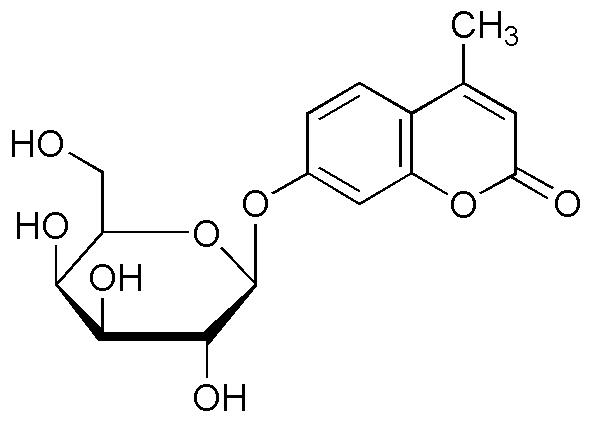4-Methylumbelliferyl-b-D-galactoside is widely utilized in research focused on:
- Enzyme Activity Assays: This compound serves as a substrate for measuring the activity of β-galactosidase in various biological samples, making it invaluable in enzymology studies.
- Cellular Studies: It is used in cell culture experiments to assess the functionality of galactosidase enzymes, aiding researchers in understanding cellular metabolism and enzyme regulation.
- Diagnostic Applications: The compound can be employed in clinical diagnostics to detect certain bacterial infections by measuring enzyme activity, providing a rapid and reliable method for diagnosis.
- Biotechnology: In genetic engineering, it is utilized as a reporter substrate to monitor gene expression, helping scientists track the effectiveness of gene delivery systems.
- Food Industry: It can be applied in food microbiology to test for the presence of specific microorganisms by evaluating enzyme activity, ensuring food safety and quality control.
General Information
Properties
Safety and Regulations
Applications
4-Methylumbelliferyl-b-D-galactoside is widely utilized in research focused on:
- Enzyme Activity Assays: This compound serves as a substrate for measuring the activity of β-galactosidase in various biological samples, making it invaluable in enzymology studies.
- Cellular Studies: It is used in cell culture experiments to assess the functionality of galactosidase enzymes, aiding researchers in understanding cellular metabolism and enzyme regulation.
- Diagnostic Applications: The compound can be employed in clinical diagnostics to detect certain bacterial infections by measuring enzyme activity, providing a rapid and reliable method for diagnosis.
- Biotechnology: In genetic engineering, it is utilized as a reporter substrate to monitor gene expression, helping scientists track the effectiveness of gene delivery systems.
- Food Industry: It can be applied in food microbiology to test for the presence of specific microorganisms by evaluating enzyme activity, ensuring food safety and quality control.
Documents
Safety Data Sheets (SDS)
The SDS provides comprehensive safety information on handling, storage, and disposal of the product.
Product Specification (PS)
The PS provides a comprehensive breakdown of the product’s properties, including chemical composition, physical state, purity, and storage requirements. It also details acceptable quality ranges and the product's intended applications.
Certificates of Analysis (COA)
Search for Certificates of Analysis (COA) by entering the products Lot Number. Lot and Batch Numbers can be found on a product’s label following the words ‘Lot’ or ‘Batch’.
Número de catálogo
Número de lote/lote
Certificates Of Origin (COO)
This COO confirms the country where the product was manufactured, and also details the materials and components used in it and whether it is derived from natural, synthetic, or other specific sources. This certificate may be required for customs, trade, and regulatory compliance.
Número de catálogo
Número de lote/lote
Safety Data Sheets (SDS)
The SDS provides comprehensive safety information on handling, storage, and disposal of the product.
DownloadProduct Specification (PS)
The PS provides a comprehensive breakdown of the product’s properties, including chemical composition, physical state, purity, and storage requirements. It also details acceptable quality ranges and the product's intended applications.
DownloadCertificates of Analysis (COA)
Search for Certificates of Analysis (COA) by entering the products Lot Number. Lot and Batch Numbers can be found on a product’s label following the words ‘Lot’ or ‘Batch’.
Número de catálogo
Número de lote/lote
Certificates Of Origin (COO)
This COO confirms the country where the product was manufactured, and also details the materials and components used in it and whether it is derived from natural, synthetic, or other specific sources. This certificate may be required for customs, trade, and regulatory compliance.


